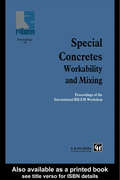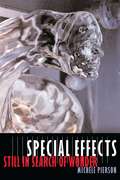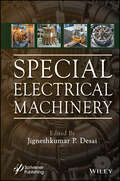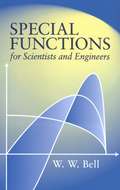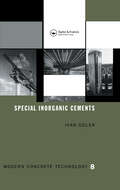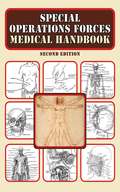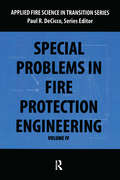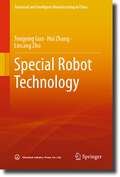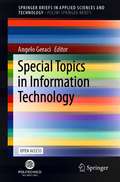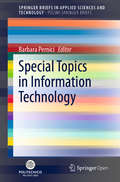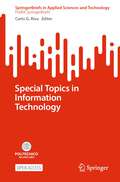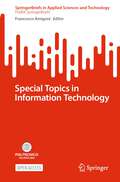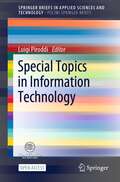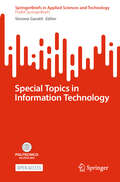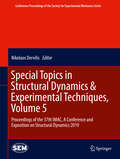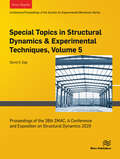- Table View
- List View
Special Concretes - Workability and Mixing
by Peter J.M.BartosThis book forms the Proceedings of the International RILEM Workshop held in Paisley in March 1993. It contains contributions on theoretical and practical aspects of the use of special concretes, with a particular focus on their behaviour in the fresh state.
Special Edition - Environmental Engineering Dictionary and Directory
by Thomas M. PankratzLike most technical disciplines, environmental science and engineering is becoming increasingly specialized. As industry professionals focus on specific environmental subjects they become less familiar with environmental problems and solutions outside their area of expertise. This situation is compounded by the fact that many environmental science
Special Educational Needs and the Internet: Issues for the Inclusive Classroom
by Chris AbbottWith Internet access for every school now a reality, teachers are beginning to explore the use of the Internet in the education of children with special needs. This book describes its benefits for children across the spectrum of special educational needs, from those with physical disabilities or sensory impairment to those with learning or social difficulties.With contributions from leading practitioners in the field, this book addresses the huge range of possibilities the Internet and associated technology offer for these pupils. Combining current theory and debate with practical guidance and inspiring case studies, this book considers:* how the Internet can be used to gather and publish information* how to communicate effectively through technology* policy and management issues for schools* the continuing challenges for access and inclusion.This book will be of interest to all teachers involved in special education needs, in both mainstream and special schools.
Special Effects: Still in Search of Wonder (Film and Culture Series)
by Michele PiersonDesigned to trick the eye and stimulate the imagination, special effects have changed the way we look at films and the worlds created in them. Computer-generated imagery (CGI), as seen in Hollywood blockbusters like Star Wars, Terminator 2, Jurassic Park, Independence Day, Men in Black, and The Matrix, is just the latest advance in the evolution of special effects. Even as special effects have been marveled at by millions, this is the first investigation of their broader cultural reception. Moving from an exploration of nineteenth-century popular science and magic to the Hollywood science fiction cinema of our time, Special Effects examines the history, advancements, and connoisseurship of special effects, asking what makes certain types of cinematic effects special, why this matters, and for whom. Michele Pierson shows how popular science magazines, genre filmzines, and computer lifestyle magazines have articulated an aesthetic criticism of this emerging art form and have helped shape how these hugely popular on-screen technological wonders have been viewed by moviegoers.
Special Electrical Machinery
by Jigneshkumar P. DesaiThis book is a comprehensive guide to specialized motors, providing in-depth information on the operating principles, applications, and controls of various special electrical machines. It covers a range of special machines, including switched reluctance motors, permanent magnet synchronous machines, brushless direct current motor, stepper motors, universal motors, and hysteresis motors. The book also addresses the issue of torque ripple. Much of the literature available today focuses solely on conventional motors and their controls, like induction motors, synchronous motors, PMDC motors, servo machines, and transformers. This book takes a broader view, addressing the growing trend toward specialized motors tailored to specific applications and new innovations in control and modification. It aims to offer comprehensive insights into these special machines by providing detailed information on their operating principles, applications, and controls. This exciting new volume: Provides application-based examples of machines not covered in other books on special machines Provides context for the use of special machines used in electric vehicle technology Gives examples which are helpful for industry practices Audience Undergraduate students, post-graduate students, researchers, and industry professionals who study and use special machines
Special Functions for Scientists and Engineers
by W. W. BellClear and comprehensive, this text provides undergraduates with a straightforward guide to special functions. It is equally suitable as a reference volume for professionals, and readers need no higher level of mathematical knowledge beyond elementary calculus. Topics include the solution of second-order differential equations in terms of power series; gamma and beta functions; Legendre polynomials and functions; Bessel functions; Hermite, Laguerre, and Chebyshev polynomials; Gegenbauer and Jacobi polynomials; and hypergeometric and other special functions. Three appendices offer convenient tabulation of principal results, and a generous supply of worked examples and problems includes some hints and solutions. 1968 edition. 25 figures.
Special Functions in Fractional Calculus and Engineering (Mathematics and its Applications)
by H. M. Srivastava R. K. Pandey Harendra SinghSpecial functions play a very important role in solving various families of ordinary and partial differential equations as well as their fractional-order analogs, which model real-life situations. Owing to the non-local nature and memory effect, fractional calculus is capable of modeling many situations which arise in engineering. This book includes a collection of related topics associated with such equations and their relevance and significance in engineering. Special Functions in Fractional Calculus and Engineering highlights the significance and applicability of special functions in solving fractional-order differential equations with engineering applications. This book focuses on the non-local nature and memory effect of fractional calculus in modeling relevant to engineering science and covers a variety of important and useful methods using special functions for solving various types of fractional-order models relevant to engineering science. This book goes on to illustrate the applicability and usefulness of special functions by justifying their numerous and widespread occurrences in the solution of fractional-order differential, integral, and integrodifferential equations.This book holds a wide variety of interconnected fundamental and advanced topics with interdisciplinary applications that combine applied mathematics and engineering sciences, which are useful to graduate students, Ph.D. scholars, researchers, and educators interested in special functions, fractional calculus, mathematical modeling, and engineering.
Special Inorganic Cements (Modern Concrete Technology)
by Ivan OdlerThe only book to cover the use of special inorganic cements instead of standard Portland cement in certain specialist applications, such as oil well drilling or in a high temperature location. Special Inorganic Cements draws together information which is widely scattered in the technical literature. It describes various special cements, their chemi
Special Operations Forces Medical Handbook
by Department of DefenseThe newest edition of the Special Operations Forces Medical Handbook is perfect and practical for both soldiers and civilians. Nearly 140 comprehensive illustrations show the proper techniques for medical care, from basic first-aid and orthopedics to instructions for emergency war surgery and even veterinary medicine. Questions are listed so that the medic can obtain an accurate patient history and perform a complete physical examination. Diagnoses are made easier with information on the distinctive features of each illness. This straightforward manual is sure to assist any reader faced with a medical issue or emergency.
Special Operations from a Small State Perspective
by Gunilla Eriksson Ulrica PetterssonThis book offers different perspectives on the utilization and development of special operations forces (SOF) in small states. Across the chapters, the authors argue that small states can use and develop this very unique capability both at a tactical and operational level, but also as a strategic instrument in the modern complex security environment. The study finds that SOF in small states has a new role to play and that it needs to become a more agile and flexible force, ready to address future security challenges. A reorientation in favour of SOF from a small state perspective is crucial both due to the changing security situation in Europe, and the need to economise military resources.
Special Problems in Fire Protection Engineering (Applied Fire Science In Transition Ser. #Vol. Iv)
by Paul R DeCiccoFeatures papers directed to fire protection in various environments other than building structures including fuel transporting vehicles, spacecraft, a sports arena, an offshore oil rig and propane fueling bus facilities.
Special Robot Technology (Advanced and Intelligent Manufacturing in China)
by Hui Zhang Tongying Guo Lincang ZhuThis book focuses on the core technologies of special robots. Both principles and engineering practice have been addressed. This is achieved by providing an in-depth study on several major topics such as the vision positioning of mobile robots, the autonomous motion control of ruin search and rescue robots, and typical applications of text questions and answers robots. The autonomous motion control technologies of ruin search and rescue robots and typical applications of text questions and answers robots are the major features of the book. The book benefits researchers, engineers, senior undergraduate students, and postgraduate students in the fields of visual positioning, path planning, autonomous motion control, and typical applications of special robots.
Special Structural Topics (Architect's Guidebooks to Structures)
by Paul W. McMullin Jonathan S. Price Sarah SimchukSpecial Structural Topics covers specialty structural situations for students and professional architects and engineers, such as soil mechanics, structural retrofit, structural integrity, cladding design, blast considerations, vibration, and structural sustainability. As part of the Architect’s Guidebooks to Structures series, it provides a comprehensive overview using both imperial and metric units of measurement with more than 150 images. As a compact summary of key ideas, it is ideal for anyone needing a quick guide to specialty structural considerations.
Special Topics in Earthquake Geotechnical Engineering
by Atilla Ansal Mohamed A. SakrGeotechnical Earthquake Engineering and Soil Dynamics, as well as their interface with Engineering Seismology, Geophysics and Seismology, have all made remarkable progress over the past 15 years, mainly due to the development of instrumented large scale experimental facilities, to the increase in the quantity and quality of recorded earthquake data, to the numerous well-documented case studies from recent strong earthquakes as well as enhanced computer capabilities. One of the major factors contributing to the aforementioned progress is the increasing social need for a safe urban environment, large infrastructures and essential facilities. The main scope of our book is to provide the geotechnical engineers, geologists and seismologists, with the most recent advances and developments in the area of earthquake geotechnical engineering, seismology and soil dynamics.
Special Topics in Information Technology (SpringerBriefs in Applied Sciences and Technology)
by Angelo GeraciThis open access book presents thirteen outstanding doctoral dissertations in Information Technology from the Department of Electronics, Information and Bioengineering, Politecnico di Milano, Italy. Information Technology has always been highly interdisciplinary, as many aspects have to be considered in IT systems. The doctoral studies program in IT at Politecnico di Milano emphasizes this interdisciplinary nature, which is becoming more and more important in recent technological advances, in collaborative projects, and in the education of young researchers. Accordingly, the focus of advanced research is on pursuing a rigorous approach to specific research topics starting from a broad background in various areas of Information Technology, especially Computer Science and Engineering, Electronics, Systems and Control, and Telecommunications. Each year, more than 50 PhDs graduate from the program. This book gathers the outcomes of the thirteen best theses defended in 2019-20 and selected for the IT PhD Award. Each of the authors provides a chapter summarizing his/her findings, including an introduction, description of methods, main achievements and future work on the topic. Hence, the book provides a cutting-edge overview of the latest research trends in Information Technology at Politecnico di Milano, presented in an easy-to-read format that will also appeal to non-specialists.
Special Topics in Information Technology (SpringerBriefs in Applied Sciences and Technology)
by Barbara PerniciThis open access book presents nine outstanding doctoral dissertations in Information Technology from the Department of Electronics, Information and Bioengineering, Politecnico di Milano, Italy. Information Technology has always been highly interdisciplinary, as many aspects have to be considered in IT systems. The doctoral studies program in IT at Politecnico di Milano emphasizes this interdisciplinary nature, which is becoming more and more important in recent technological advances, in collaborative projects, and in the education of young researchers. Accordingly, the focus of advanced research is on pursuing a rigorous approach to specific research topics starting from a broad background in various areas of Information Technology, especially Computer Science and Engineering, Electronics, Systems and Controls, and Telecommunications. Each year, more than 50 PhDs graduate from the program. This book gathers the outcomes of the nine best theses defended in 2018-19 and selected for the IT PhD Award. Each of the nine authors provides a chapter summarizing his/her findings, including an introduction, description of methods, main achievements and future work on the topic. Hence, the book provides a cutting-edge overview of the latest research trends in Information Technology at Politecnico di Milano, presented in an easy-to-read format that will also appeal to non-specialists.
Special Topics in Information Technology (SpringerBriefs in Applied Sciences and Technology)
by Carlo G. RivaThis open access book presents outstanding doctoral dissertations in Information Technology from the Department of Electronics, Information and Bioengineering, Politecnico di Milano, Italy. Information Technology has always been highly interdisciplinary, as many aspects have to be considered in IT systems. The doctoral studies program in IT at Politecnico di Milano emphasizes this interdisciplinary nature, which is becoming more and more important in recent technological advances, in collaborative projects, and in the education of young researchers.Accordingly, the focus of advanced research is on pursuing a rigorous approach to specific research topics starting from a broad background in various areas of Information Technology, especially Computer Science and Engineering, Electronics, Systems and Control, and Telecommunications.Each year, more than 50 PhDs graduate from the program. This book gathers the outcomes of the best theses defended in 2021-22 and selected for the IT PhD Award. Each of the authors provides a chapter summarizing his/her findings, including an introduction, description of methods, main achievements and future work on the topic. Hence, the book provides a cutting-edge overview of the latest research trends in Information Technology at Politecnico di Milano, presented in an easy-to-read format that will also appeal to non-specialists.
Special Topics in Information Technology (SpringerBriefs in Applied Sciences and Technology)
by Francesco AmigoniThis open access book presents outstanding doctoral dissertations in Information Technology from the Department of Electronics, Information and Bioengineering, Politecnico di Milano, Italy. Information Technology has always been highly interdisciplinary, as many aspects have to be considered in IT systems. The doctoral studies program in IT at Politecnico di Milano emphasizes this interdisciplinary nature, which is becoming more and more important in recent technological advances, in collaborative projects, and in the education of young researchers. Accordingly, the focus of advanced research is on pursuing a rigorous approach to specific research topics starting from a broad background in various areas of Information Technology, especially Computer Science and Engineering, Electronics, Systems and Control, and Telecommunications. Each year, more than 50 Ph.D.s. graduate from the program. This book gathers the outcomes of the best theses defended in 2022–23 and selected for the IT Ph.D. Award. Each of the authors provides a chapter summarizing his/her findings, including an introduction, description of methods, main achievements and future work on the topic. Hence, the book provides a cutting-edge overview of the latest research trends in Information Technology at Politecnico di Milano, presented in an easy-to-read format that will also appeal to non-specialists.
Special Topics in Information Technology (SpringerBriefs in Applied Sciences and Technology)
by Luigi PiroddiThis open access book presents thirteen outstanding doctoral dissertations in Information Technology from the Department of Electronics, Information and Bioengineering, Politecnico di Milano, Italy. Information Technology has always been highly interdisciplinary, as many aspects have to be considered in IT systems. The doctoral studies program in IT at Politecnico di Milano emphasizes this interdisciplinary nature, which is becoming more and more important in recent technological advances, in collaborative projects, and in the education of young researchers.Accordingly, the focus of advanced research is on pursuing a rigorous approach to specific research topics starting from a broad background in various areas of Information Technology, especially Computer Science and Engineering, Electronics, Systems and Control, and Telecommunications.Each year, more than 50 PhDs graduate from the program. This book gathers the outcomes of the thirteen best theses defended in 2020-21 and selected for the IT PhD Award. Each of the authors provides a chapter summarizing his/her findings, including an introduction, description of methods, main achievements and future work on the topic. Hence, the book provides a cutting-edge overview of the latest research trends in Information Technology at Politecnico di Milano, presented in an easy-to-read format that will also appeal to non-specialists.
Special Topics in Information Technology (SpringerBriefs in Applied Sciences and Technology)
by Simone GarattiThis open access book presents outstanding doctoral dissertations in Information Technology from the Department of Electronics, Information, and Bioengineering, Politecnico di Milano, Italy. Information technology has always been highly interdisciplinary, as many aspects have to be considered in IT systems. The doctoral studies program in IT at Politecnico di Milano emphasizes this interdisciplinary nature, which is becoming more and more important in recent technological advances, in collaborative projects, and in the education of young researchers. Accordingly, the focus of advanced research is on pursuing a rigorous approach to specific research topics starting from a broad background in various areas of Information Technology, especially computer science and engineering, electronics, systems and control, and telecommunications. Each year, more than 50 Ph.Ds. graduate from the program. This book gathers the outcomes of the best theses defended in 2023–24 and selected for the IT Ph.D. award. Each of the authors provides a chapter summarizing his/her findings, including an introduction, description of methods, main achievements, and future work on the topic. Hence, the book provides a cutting-edge overview of the latest research trends in information technology at Politecnico di Milano, presented in an easy-to-read format that will also appeal to non-specialists.
Special Topics in Structural Dynamics & Experimental Techniques, Vol. 5: A Conference and Exposition on Structural Dynamics 2024 (Conference Proceedings of the Society for Experimental Mechanics Series)
by Dario Di MaioSpecial Topics in Structural Dynamics & Experimental Techniques, Volume 5: Proceedings of the 42nd IMAC, A Conference and Exposition on Structural Dynamics, 2024, the fifth volume of ten from the Conference brings together contributions to this important area of research and engineering. The collection presents early findings and case studies on fundamental and applied aspects of Structural Dynamics, including papers on: Active Control Experimental Techniques Finite Element Techniques Multifunction Structures System Identification Additive Manufacturing Rotating Machinery
Special Topics in Structural Dynamics & Experimental Techniques, Vol. 5: Proceedings of the 42nd IMAC, A Conference and Exposition on Structural Dynamics 2024
by Dario Di MaioSpecial Topics in Structural Dynamics & Experimental Techniques, Volume 5: Proceedings of the 42nd IMAC, A Conference and Exposition on Structural Dynamics, 2024, the fifth volume of ten from the Conference brings together contributions to this important area of research and engineering. The collection presents early findings and case studies on fundamental and applied aspects of Structural Dynamics, including papers on: Active Control Experimental Techniques Finite Element Techniques Multifunction Structures System Identification Additive Manufacturing Rotating Machinery.
Special Topics in Structural Dynamics & Experimental Techniques, Volume 5: Proceedings of the 37th IMAC, A Conference and Exposition on Structural Dynamics 2019 (Conference Proceedings of the Society for Experimental Mechanics Series)
by Nikolaos DervilisSpecial Topics in Structural Dynamics & Experimental Techniques, Volume 5: Proceedings of the 37th IMAC, A Conference and Exposition on Structural Dynamics, 2019, the fifth volume of eight from the Conference brings together contributions to this important area of research and engineering. The collection presents early findings and case studies on fundamental and applied aspects of Structural Dynamics, including papers on:Analytical MethodsEmerging Technologies for Structural DynamicsEngineering ExtremesExperimental TechniquesFinite Element TechniquesGeneral Topics
Special Topics in Structural Dynamics & Experimental Techniques, Volume 5: Proceedings of the 38th IMAC, A Conference and Exposition on Structural Dynamics 2020
by David S. EppSpecial Topics in Structural Dynamics & Experimental Techniques, Volume 5: Proceedings of the 38th MAC, A Conference and Exposition on Structural Dynamics, 2020, the fifth volume of eight from the Conference brings together contributions to this important area of research and engineering. The collection presents early findings and case studies on fundamental and applied aspects of Structural Dynamics, including papers on: Analytical Methods Emerging Technologies for Structural Dynamics Engineering Extremes Experimental Techniques Finite Element Techniques General Topics.
Special Topics in Structural Dynamics & Experimental Techniques, Volume 5: Proceedings of the 38th IMAC, A Conference and Exposition on Structural Dynamics 2020 (Conference Proceedings of the Society for Experimental Mechanics Series)
by David S. EppSpecial Topics in Structural Dynamics & Experimental Techniques, Volume 5: Proceedings of the 38th MAC, A Conference and Exposition on Structural Dynamics, 2020, the fifth volume of eight from the Conference brings together contributions to this important area of research and engineering. The collection presents early findings and case studies on fundamental and applied aspects of Structural Dynamics, including papers on:Analytical MethodsEmerging Technologies for Structural DynamicsEngineering ExtremesExperimental TechniquesFinite Element TechniquesGeneral Topics
